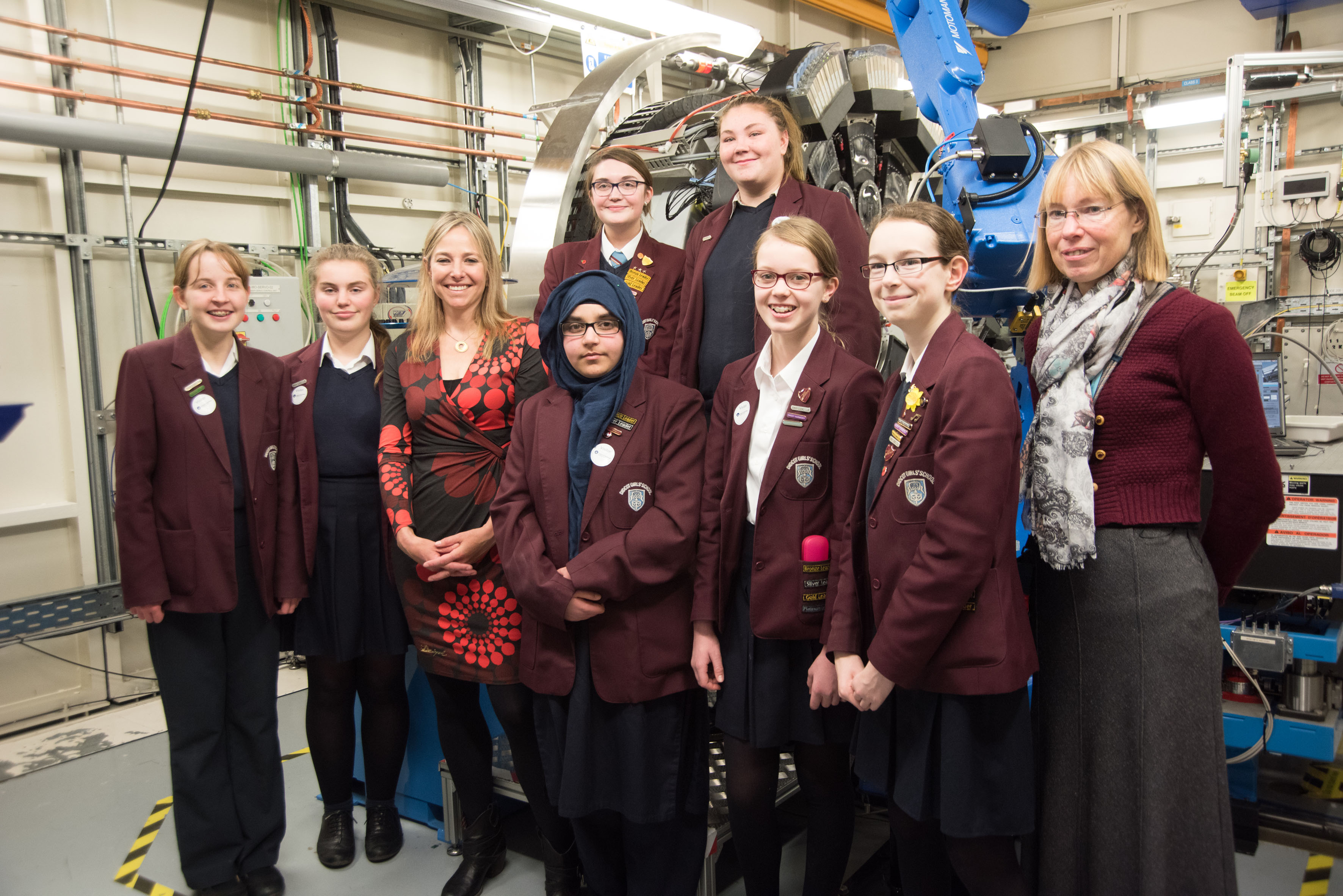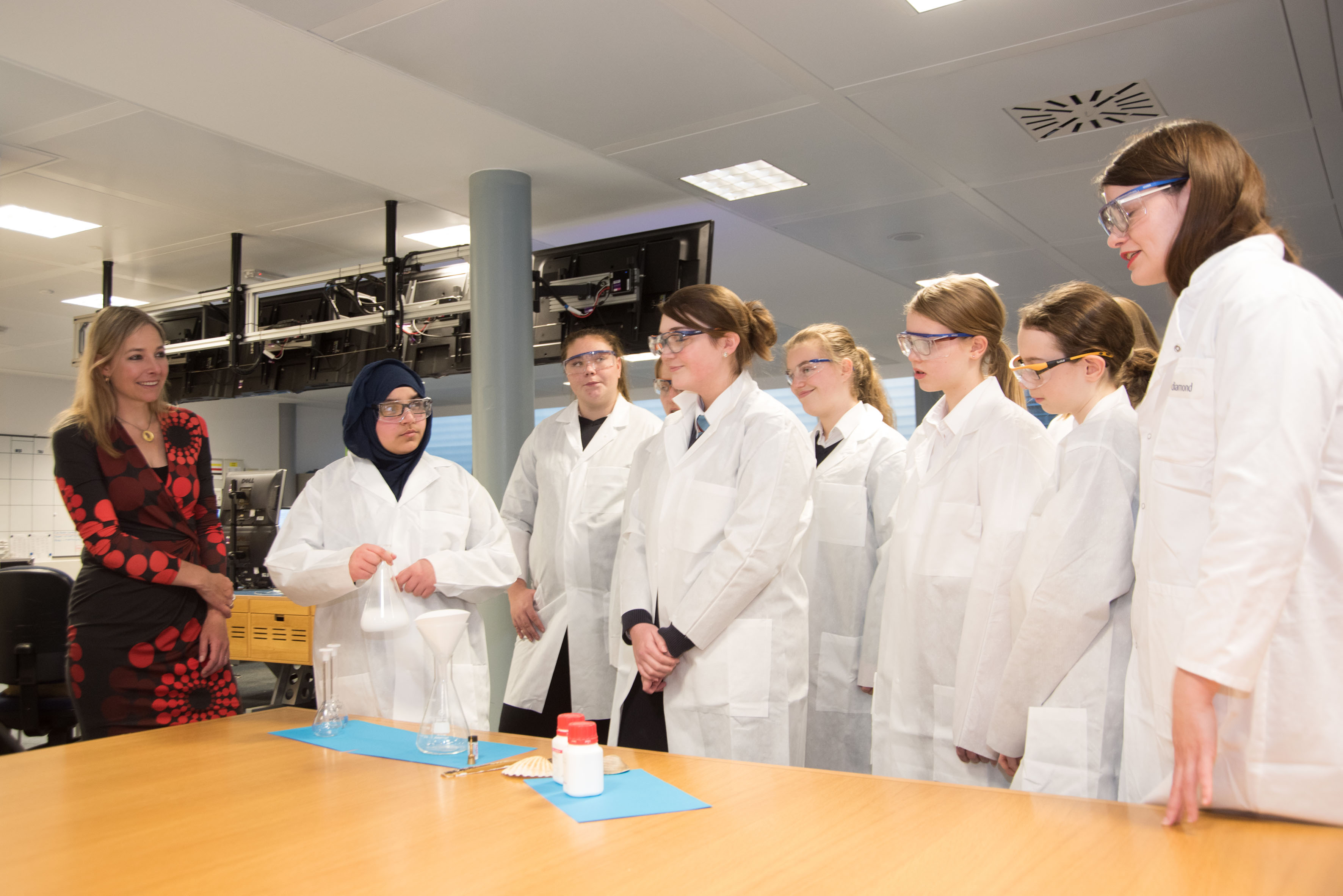Find out more about our ambitious upgrade project, delivering more brightness, more coherence, and greater speed of analysis to UK science. More about Diamond-II
![]()
Find out more about Diamond's response to virus research.
![]()
Schools from all over the UK are to participate in a pioneering citizen science project, launched this week by celebrity scientist Professor Alice Roberts.
Project M will involve hundreds of school students across the UK in brand new research being conducted for the very first time. The initiative allows 14-18 year olds to contribute to cutting-edge research, take part in genuine experiments and publish their results in a scientific peer-reviewed journal.
Professor Alice Roberts joined students from Didcot Girls’ School, who are piloting the project, at Diamond in Oxfordshire to launch Project M. The 100 participating schools will help scientists to better understand one of the most important minerals on the planet, calcium carbonate.

Calcium carbonate is a common substance found in a variety of items, from limestone and pearls to egg shells and broccoli. Over the coming months, each school will receive a Project M information pack which they will use to create 10 samples of calcium carbonate mixed with specially selected additives. These will then be sent back to the Diamond facility to be analysed during a 24-hour period in April 2017.
Professor Alice Roberts, who is a keen supporter of public engagement in science, comments: “Science isn’t just about what we already know - it’s about how we keep on learning about the world around us. Project M offers young people the fantastic opportunity to become involved with a huge experiment - to find out for themselves how science is carried out, and even have their results published in an academic journal. This is a science practical with a difference - we genuinely don’t know what the discoveries will be. I’m delighted to have helped Diamond Light launch this ambitious and exciting project."
Professor Andrew Harrison says: “Project M is a unique way of getting schools involved in important research and making science fun and engaging for young people. We want students and their teachers to understand more about the great scientific studies and breakthroughs that occur right here in the UK, and we’re hoping that Project M will help us to do so. Some that take part in the project may actually end up as scientists working in facilities like Diamond one day.”

Lynn Nickerson, STEM Coordinator at Didcot Girls' School, says: “Project M is fantastic because it gives students the chance to participate in real science. Unlike most regular lessons, we don’t have the answers to this experiment already - we don’t know the solution, and that makes it all far more exciting for students.
“We’re all thrilled to be involved in the pilot. What we are doing with this project will be rolled out to schools around the country, and that inspires us to really do our best work, because we know it really matters; we’ve helped to design the protocol for the project as well as taking part in the trial run. We found that making calcium carbonate was the easy part; the hard part was getting the sample into the sample tube, which is only about as wide as a human hair! Luckily, we had one student with a real knack for it!
“The greatest benefit of Project M is that you don’t have to be a professional scientist to take part in what is a very real experiment. As long as students have the enthusiasm and are prepared to work hard, their efforts can contribute to the big picture.”
Diamond is comparable to a giant microscope, and works by harnessing the power of electrons to produce a bright light that scientists use to study anything from fossils and jet engines, to viruses and vaccines. Diamond has recently published its 5000th research paper, and the facility has supported an array of scientific advances and breakthroughs since it began operation, just over ten years ago.
For instance, technology was developed at Diamond to help design a new synthetic vaccine to protect against the foot and mouth disease virus– technology is now being used by scientists from the UK and USA to target the virus that causes polio. Diamond has also supported progress in a number of other fields, including green energy solutions, advanced engineering and nanotechnology.
To register to receive an information pack for your school, please contact [email protected].
Each school will receive an information pack with instructions, and will need to submit their findings to Diamond by Friday 7 April 2017.
Diamond Light Source is the UK's national synchrotron science facility, located at the Harwell Science and Innovation Campus in Oxfordshire.
Copyright © 2022 Diamond Light Source
Diamond Light Source Ltd
Diamond House
Harwell Science & Innovation Campus
Didcot
Oxfordshire
OX11 0DE
Diamond Light Source® and the Diamond logo are registered trademarks of Diamond Light Source Ltd
Registered in England and Wales at Diamond House, Harwell Science and Innovation Campus, Didcot, Oxfordshire, OX11 0DE, United Kingdom. Company number: 4375679. VAT number: 287 461 957. Economic Operators Registration and Identification (EORI) number: GB287461957003.